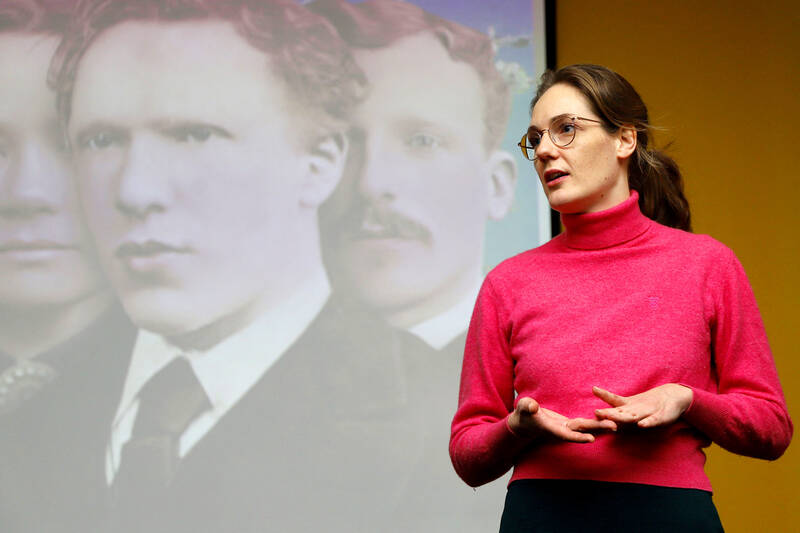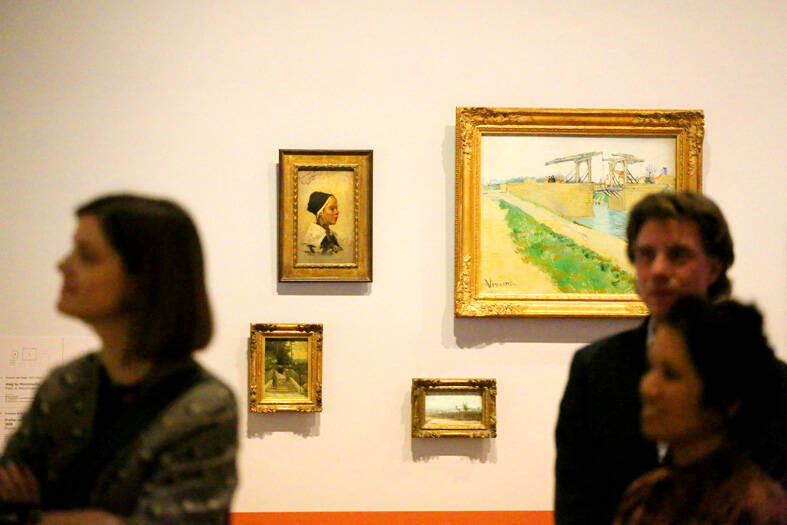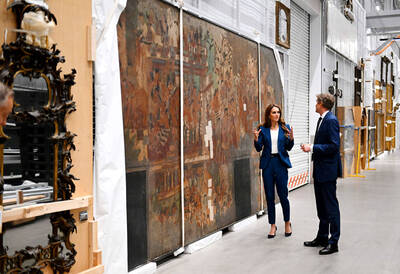He’s one of the most famous artists in history. But Vincent van Gogh could have faded into obscurity were it not for his family — and the vision of one woman.
The Van Gogh Museum in Amsterdam launched its 50th anniversary celebrations on Wednesday with a new exhibit hailing their often under-appreciated role. “Choosing Vincent,” which opens Friday until April 10, not only features several of the Dutch master’s famous paintings, but also rarely-seen objects including his birth certificate and the only-known photograph of him in existence.
It pays homage to the tireless work of Vincent’s beloved brother Theo and, in particular, Theo’s widow Jo Van Gogh-Bonger, who dedicated her life to making sure the world saw the genius of Vincent’s works.

Photo: AFP
“Jo contributed greatly to the fame of Vincent,” curator Lisa Smit said.
Van Gogh sold only a handful of paintings during his lifetime, and at the time of his death in 1890 after a self-inflicted gunshot wound was often wracked with self-doubt about his talent.
Theo died six months after Vincent, in 1891, leaving Jo Van Gogh-Bonger with a large collection of paintings by a virtually unknown artist.

Photo: AFP
’ALL IMPORTANT LIFE DECISION’
“At this point in time, Jo is a young woman of 28 and she has a little boy who hasn’t even turned one yet,” said Smit. “So what is she going to do with this collection? Is she going to keep it, is she going sell it? She really has to make that all-important life decision.”
The answer to that question created the Van Gogh we know now — whose paintings including Sunflowers and Irises are among the most expensive ever sold.
“A few months after Theo’s death she writes in her diary that she wants to make it her mission to follow Theo’s dream to find recognition for her brother in law, which she does for the rest of her life,” said Smit.
She not only preserved the paintings but also looked after the correspondence between her husband and her brother in law, which would later be published as Dear Theo.
Theo and Jo’s son, named Vincent after his artist uncle, continued keeping the collection intact and was instrumental in handing it over in its entirety to the Vincent van Gogh Foundation in 1962.
Part of the deal was the building of a museum to house Van Gogh’s works including other famous paintings like “Wheatfield with Crows” and self-portraits.
’TELLS A STORY’
“Choosing Vincent” prominently features the iconic work Almond Blossom — which Vincent painted as a gift to his namesake nephew in 1890 a few months before his death.
The Japanese-influenced work was one of the hundreds of Van Gogh’s paintings handed over to the Foundation in 1962.
In 1973 the museum opened its doors to the public as the Rijksmuseum Vincent van Gogh.
The museum changed its name to the Van Gogh Museum in 1994 and today houses more than 200 paintings, 500 drawings and around 800 letters in the largest collection globally by the painter.
“This is an exhibition that tells a story,” said Van Gogh Museum Director Emilie Gordenker.
“A story about Vincent, but also his family and how close they were and what they meant to each other.”

June 9 to June 15 A photo of two men riding trendy high-wheel Penny-Farthing bicycles past a Qing Dynasty gate aptly captures the essence of Taipei in 1897 — a newly colonized city on the cusp of great change. The Japanese began making significant modifications to the cityscape in 1899, tearing down Qing-era structures, widening boulevards and installing Western-style infrastructure and buildings. The photographer, Minosuke Imamura, only spent a year in Taiwan as a cartographer for the governor-general’s office, but he left behind a treasure trove of 130 images showing life at the onset of Japanese rule, spanning July 1897 to

One of the most important gripes that Taiwanese have about the Democratic Progressive Party (DPP) is that it has failed to deliver concretely on higher wages, housing prices and other bread-and-butter issues. The parallel complaint is that the DPP cares only about glamor issues, such as removing markers of Chinese Nationalist Party (KMT) colonialism by renaming them, or what the KMT codes as “de-Sinification.” Once again, as a critical election looms, the DPP is presenting evidence for that charge. The KMT was quick to jump on the recent proposal of the Ministry of the Interior (MOI) to rename roads that symbolize

On the evening of June 1, Control Yuan Secretary-General Lee Chun-yi (李俊俋) apologized and resigned in disgrace. His crime was instructing his driver to use a Control Yuan vehicle to transport his dog to a pet grooming salon. The Control Yuan is the government branch that investigates, audits and impeaches government officials for, among other things, misuse of government funds, so his misuse of a government vehicle was highly inappropriate. If this story were told to anyone living in the golden era of swaggering gangsters, flashy nouveau riche businessmen, and corrupt “black gold” politics of the 1980s and 1990s, they would have laughed.

Imagine being able to visit a museum and examine up close thousand-year-old pottery, revel alone in jewelry from centuries past, or peer inside a Versace bag. Now London’s V&A has launched a revolutionary new exhibition space, where visitors can choose from some 250,000 objects, order something they want to spend time looking at and have it delivered to a room for a private viewing. Most museums have thousands of precious and historic items hidden away in their stores, which the public never gets to see or enjoy. But the V&A Storehouse, which opened on May 31 in a converted warehouse, has come up